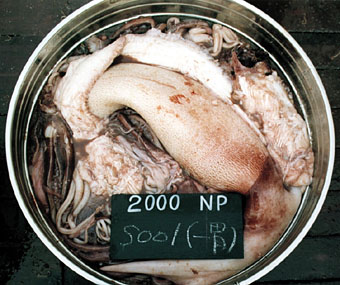
Contents
of the first stomach of sperm whale caught off Hokkaido. (Photo by T. Tamura, Research
Institute of Cetacea)
The mantel in the center is identical to Moroteuthis robusta.
Click on the image to get a lager view. |
|
Samples for stomach contents analysis are brought into the laboratory as
a whole body of predators or only predator stomachs . from the body. They
are under deeply frozen or preserved in formalin.
For frozen samples, biological measurements (body length, body weight etc.)
should be achieved after thawing and the stomach is cut out from the body
pinching both ends tightly and measured weight with contents. Then, contents
are removed from the stomach rinsing stomach wall carefully, and empty
stomach is measured again. Stomach contents weight (SCW) is deduced subtracting
the empty stomach weight from the whole stomach weight.
Stomach
contents are sorted into possible groups, i.e. fresh fish, fresh cephalopods,
fresh zooplankton, digested fish tissue, digested cephalopod tissue including
buccal mass, fish otolith, and cephalopod beaks and statoliths. Fresh and half
digested tissues are preserved in formalin (about 10%). Fish otolith and
cephalopod statolith must be stored in alcohol (70% of ethyl alcohol, 40% of isopropyl
alcohol). Beaks are also recommended to store in alcohol.
Samples which were preserved in formalin in the fields, it is
better sorted otolith and statolith as soon as possible and transfer them into
alcohol due to decarboxylation of formalin solution.
Do not forget putting
a water-proof label which records predator, size, weight, sex, sampling date,
sampling methods, locality, etc in each of storing bottles. |